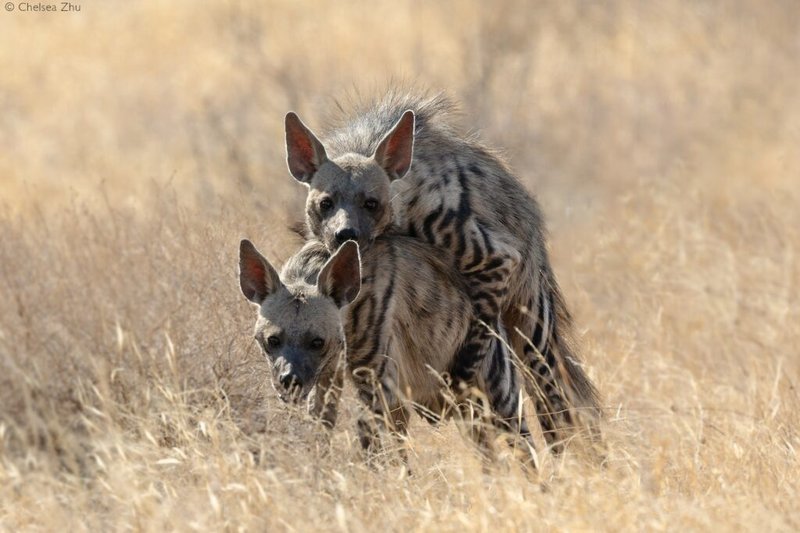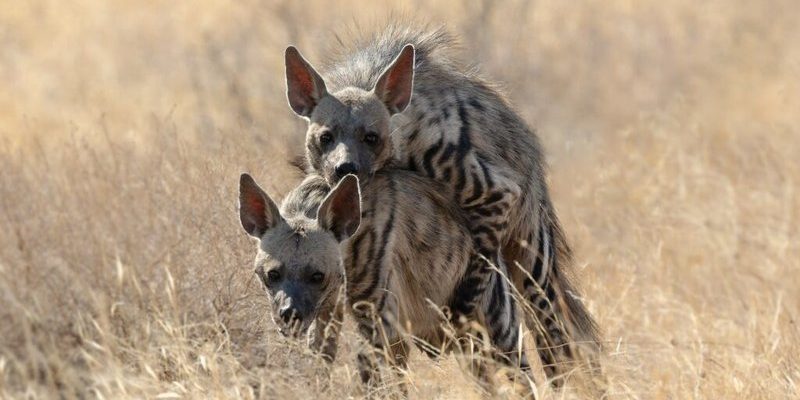
So, how do they do it? It’s like they’ve got their own toolkit for survival. They’ve got adaptations and behavior that help them not just endure, but actually flourish where many other animals would struggle. Think of them like the ultimate survivalists in nature’s unpredictable game. Let’s dig in and explore how striped hyenas make the most of their challenging habitats.
Physical Adaptations That Aid Survival
Striped hyenas have a set of physical traits that enable them to thrive in their tough environments. First off, their robust bodies are designed for endurance. With strong muscles and relatively short legs, they can travel long distances without getting worn out easily. This is crucial when food isn’t always nearby.
Their thick fur serves a dual purpose. It keeps them warm during cold nights and protects them from the harsh sun during the day. You might say it’s like wearing a high-tech jacket that adjusts to the temperature. Plus, the stripes on their fur help with camouflage. When they’re hiding among rocks or dried grasses, their markings make them less visible to both prey and predators.
Another standout feature is their powerful jaws. Striped hyenas have incredibly strong teeth that allow them to crush bones and consume carcasses that other scavengers might leave behind. This means they can find food in places where other animals struggle, giving them an advantage in survival. In a world where every meal counts, these adaptations are like having a secret weapon tucked away.
Behavioral Strategies for Finding Food
When it comes to finding food, striped hyenas are smart cookies. They are primarily scavengers, meaning they often rely on the leftovers of other predators. But here’s the thing: they don’t just wait around for dinner to come to them. They actively search for carcasses, covering vast areas to find a meal.
Their social behavior plays a huge role too. Striped hyenas are not as solitary as some might think. They often hunt in small family groups, which increases their chances of spotting food and helps them fend off competition. By working together, they can tackle larger prey or defend their find from other scavengers. Imagine a family team working together to gather supplies for a feast—it’s much more effective than going solo!
Additionally, these hyenas have a keen sense of smell, which is essential for locating food over long distances. They can detect the scent of rotting meat from miles away! This powerful olfactory ability ensures they don’t miss out on potential meals that others might overlook.
Water Conservation Techniques
In harsh environments, water is gold. Striped hyenas have adapted to make the most out of limited water sources. They can survive on very little water compared to other mammals. Their kidneys are incredibly efficient, allowing them to extract moisture from the food they eat and reduce water loss through urine.
You might wonder how they manage during dry seasons. Well, they are opportunistic feeders, consuming a variety of foods such as fruits, insects, and small mammals when meat is scarce. This not only diversifies their diet but also helps them stay hydrated. Think of it like choosing different snacks to keep energy levels up—variety is key!
Moreover, striped hyenas have been observed digging for water or even raiding the dens of other animals that may have stored water. It’s all about being resourceful, and these clever creatures certainly know how to play the long game.
Adaptations to Extreme Weather
Living in extreme conditions means facing tough weather. Striped hyenas have some cool tricks up their sleeves to handle this. During the searing heat of the day, they tend to be more nocturnal, becoming active at night when temperatures drop. This switch helps them avoid overheating and makes hunting easier under the cover of darkness.
In colder environments, their thick fur and robust build help keep them warm. They often use dens and hidden shelters to shield themselves from the elements. These spaces not only provide safety from the wind and rain but also create a cozy spot to rest.
When the weather gets really extreme, hyenas can enter a sort of semi-hibernation, reducing their activity levels until conditions improve. It’s like putting your feet up during a storm and waiting for the skies to clear!
Social Structure and Group Dynamics
The social structure of striped hyenas is fascinating. They live in small family units, often led by an alpha female. This matriarchal structure means that kinship plays a vital role in their survival. Staying close to family not only fosters cooperation during hunts but also provides mutual protection against intruders.
Their social interactions include vocalizations, body language, and even playful behaviors, which strengthen bonds within the group. These connections are vital in a harsh setting, where working together can mean the difference between finding food or going hungry.
Interestingly, younger hyenas learn crucial survival skills from older members of the pack. This mentoring helps maintain the group’s knowledge and improves their chances in an unforgiving environment.
Conservation Challenges and Their Impact
Despite their impressive abilities, striped hyenas face significant challenges. Habitat destruction, poaching, and human-wildlife conflict are just a few issues that threaten their populations. As environments change, these animals have to adapt quickly, often to their detriment.
You might be wondering, why does this matter? Well, striped hyenas play an essential role in their ecosystems. As scavengers, they help clean up the environment by consuming carrion, which helps prevent the spread of disease. Losing them could have a domino effect, disrupting the delicate balance of their habitats.
Conservation efforts are crucial to ensuring their survival. Raising awareness and protecting their habitats can help these remarkable creatures continue to thrive in the wild. After all, their ability to adapt and survive is something we can all learn from.
The Future of Striped Hyenas
Looking ahead, the future of striped hyenas depends on a mix of protection and adaptability. Conservationists are working tirelessly to restore habitats and create protected areas where these hyenas can roam freely. This means they’ll have access to food, water, and safe living conditions—just as nature intended.
Moreover, understanding their behavior and ecology can inform better strategies for coexistence with humans. As we learn more about how these animals navigate their environments, it helps us appreciate the intricate dance of nature and our role in protecting it.
In conclusion, striped hyenas are not just survivors; they are clever, resourceful, and essential players in their ecosystems. By recognizing their value and the challenges they face, we can ensure these extraordinary animals continue to thrive for generations to come. So, the next time you think of hyenas, remember the fierce adaptability and resilience that allow them to flourish in harsh environments, just like nature’s own survival experts!

